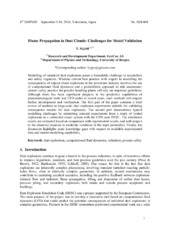Flame Propagation in Dust Clouds: Challenges for Model Validation
Abstract
Modelling of industrial dust explosions poses a formidable challenge to researchers and safety engineers. Whereas current best practice with respect to modelling the consequences of vapour cloud explosions in the petroleum industry involves the use of computational fluid dynamics and a probabilistic approach to risk assessment, current safety practice for powder handling plants still rely on empirical guidelines. Although there has been significant progress in the predictive capabilities of phenomenological tools and CFD codes in recent years, such methods still require further development and verification. The first part of the paper contains a brief review of medium to large-scale dust explosion experiments suitable for validating consequence models for dust explosions. The second part demonstrates typical modelling challenges by simulating selected experiments from a study of vented explosions in a connected vessel system with the CFD code DESC. The simulation results are evaluated based on comparison with experimental results, and with respect to the observed response to moderate variations in the input parameters. Finally, the discussion highlights main knowledge gaps with respect to available experimental data and current modelling capabilities.
